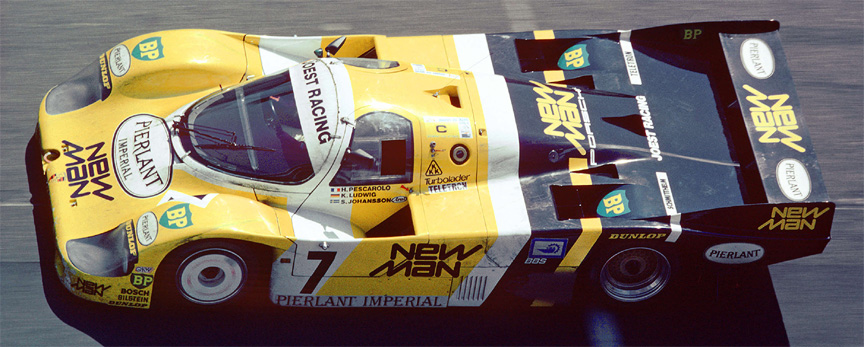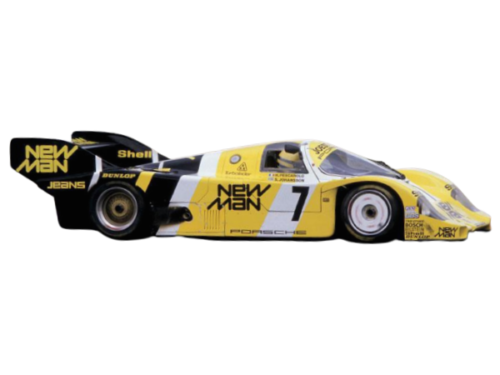Porsche 956B (1984 – 1985)
Achievements: Le Mans winner 1984 – 1985
An Updated 956
In 1984 Porsche offered a full works-specification car known as the 956B. This provided the New-Man Joest Racing team with a winning formula and they dominated the 1985 24 Hours of Le Mans with a resounding victory. One of the main differences between the customer 956 and the 956B was the Bosch Motronic engine management. This allowed more precise ignition and injection which in turn provided better economy and more power.
Dominance
In 1984 the International Motor Sport Association (IMSA) the nearest equivalent to the WSC in North America was another championship that Porsche was keen to enter with the same successful mould they had from the WSC. However there was a problem, the fact that the drivers feet were in front of the imaginary line between the centres of the front wheel, this was not allowed under IMSA rules, from this the 962 was created, although virtually identical to the 956 it had a slightly longer wheel base to accommodate the rule change necessary for entry into IMSA. The Porsche 962 was not available for the whole of the 1984 IMSA season, it managed to win 5 races all at the hands of the Holbert racing Lowenbrau sponsored car, Al Holbert and Derek Bell the drivers. This car would prove to be extremely successful in IMSA, the combination of Holbert and Derek Bell’s amazing skill in endurance racing went on to yield numerous wins and championships.
The domination continued in 1984, 10 WSC races entered, 10 wins for Porsche 956’s, the factory team taking 7 (the 11th WSC race was won by Lancia with no Porsche opposition). Due to a dispute between Porsche and Automobile Club de l’Ouest the factory team boycotted the 1984 Le Mans race, this left the door open for the customer teams to prosper. The disagreement centred around the organisers of Le Mans allowing Group C cars better fuel regulations than cars designed to IMSA spec, Porsche felt this rendered their new 962’s handicapped and was not fair. With no factory presence the Newman Joest team’s 956 won Le Mans with Klaus Ludwig and Henri Pescarolo. The first 7 places were all 956’s. The 956’s that Porsche built in 1984 were a slightly different specification to previous cars, these were called 956B.
1985 saw the Porsche factory team entering 962’s, there were customer 962 entries as well as 956 entries. Little changed through WSC season with the Rothmans 962’s winning 6 of the 9 races and once again as in the last few years the drivers championship went to the factory drivers. Le Mans featured a return of the Rothmans cars, however after the team were uncharacteristically hampered by technical difficulties, the new factory 962’s were beaten by the older 956, in particular the same 956 chassis from the year before. Joest racing took the win with Klaus Ludwig, Paolo Barilla and John Winter.
1985 was also the first year that the 962 was run in full in the IMSA, all the cars in the IMSA were customer privateers, the Al Holbert Lowenbrau car enjoyed a success at the hand of its owner taking the championship with help from Derek Bell and Al Unser Jr. The IMSA rules and the fact that all teams were customers meant their spec differed from WSC cars, the Holbert car used a 3.2 single turbo flat 6, hence the large air intake on the top of the rear clamshell, engine sizes and turbo configuration varied from team to team, but typically IMSA cars produced 700bhp+.
1986 and 1987 were years that saw transition for the 956/962, 1986 in WSC the 962 was again the best car in the field winning 7 of the 9 races. The main difference to previous seasons was the factory teams dominance ended, they still won 2 of the races however the customer teams were becoming ever more successful. Walter Bruns team won 3 of the races and two other privateers winning two other races, the 7 wins were also shared between 956 and 962’s. The Brun team claimed the Team Championship going some way to making up for the tragic 1985 season, Brun also won the 1986 Spa 1000km, this to me was a fitting tribute to Stefan Bellof.
Le Mans was the factories chance for revenge on the Joest team that had beaten them 12 months before. The race itself until two-thirds in looked like it was going to be extremely close, the Joest car pushing the Rothmans Bell/Stuck/Holbert car very hard. Eventually the no1 Porsche won after the other contenders succumbed to the challenges of the race, the Jaguars now looked like quite a rival to the Porsches, but on this occasion even the might V12 was not enough to catch the cars from Stuttgart. In the case of the WSC the 962’s days were coming to an end, maybe one more…….
Porsche 956B Basics
| Engine | 2.65 L F6 twin-turbo, 4 valves per cylinder, water-cooled cylinder heads, air-cooled cylinders |
| Weight | 820-855 kg / 1800-1900 lb |
| Fuel tank | 99 L (allowed size 100 L) |
| Dimensions | length 4800 mm, wheelbase 2650 mm (allowed length tied to wheelbase), width 2000 mm (allowed maximum) |
| Top speed | 218+ mph/350+ km/h |
| Production | 25 (28 numbered chassis built, but some used to rebuild crashed cars). Includes 956 and 956B. |
Type 935/79 (1983 – 1986)
| Displacement | 2.65-litre (subsequently 2869 cc, 2994 cc and 3164 cc) |
| Horsepower | 620 bhp @ 8200 rpm; 1.2 bar boost (2.649-litre) |
| Torque | 465 ft lbs |
| Turbochargers | Twin turbo KKK K26 |
| Cooling | Water-cooled cylinder heads, air-cooled cylinders with fan |
| ECU | Bosch 1.2 Motronic engine management |
The Porsche 956B & Racing Story
In 1983 FIA had announced a new rule for the coming 1984 season – maximum allowed average fuel consumption of 51 L/100 km instead of earlier 60 L/100 km. As a result Porsche created the 956 B with Bosch electronic fuel injection. Then, in March 1984, three months before the Le Mans race, the new fuel consumption rule was discarded. This was an insult to Porsche – a lot of work was done over the year for nothing. In protest against the short-notice rule change concerning fuel consumption and weight, the factory team boycoted the race.

Fourteen (!) 956s were entered by private racing teams and the result list was almost like the year before – first seven places went to 956. The race was won by New-Man sponsored Joest Racing 956 #7 driven by Henri Pescarolo/Klaus Ludwig. Both men had won the race already before (now Pescarolo’s fourth victory and Ludwig’s second). For the 1984 season Porsche had also created a version of the 956 for the American market, called the 962. The IMSA rules demanded a safer cockpit for the driver and didn’t allow more than one turbo. Two private 962s were entered for Le Mans, one belonging to the Swap Shop sponsored team and the other to Skoal Bandit team. Unfortunately the Swap Shop car with the single K36 turbocharger had to retire because of the ignition system failure and the other 962-chassis car because of an accident. Luckily both racing teams had 956s, too, that would finish on podium.


In addition to the Le Mans victory, the 1984 season brought again many victories to 956: Suzuka 500 km, Monza 1000 km, Silverstone 1000 km, Fuji 500 km, Norisring 200 miles, Nürburgring 1000 km, Brands Hatch 1000 km, Mosport 1000 km, Suzuka 1000 km, Spa 1000 km, Imola 1000 km, Fuji 1000 km, Fuji 500 mile, Sandown 1000 km…

Le Mans 1985: despite the factory team participating with the 962 C cars, the race was won again by the same team, same car and even one of the drivers as last year – the #7 956 (chassis 956-117) of New-Man sponsored Joest Racing. For 1985 Klaus Ludwig was accompanied by John Winter (Louis Krages) and Paolo Barilla. It was Klaus Ludwig’s third Le Mans victory (all achieved with Porsches). The second place was taken by Richard Lloyd team 956. This was 10th overall victory for Porsche and it now overtook Ferrari (nine outright wins).

Although the factory team is not using the 956 anymore in 1985, in the private hands it manages to score Fuji 1000 km and Norisring 200 miles race victories in addition to the Le Mans.
For the 1986 Le Mans 24 hour race the Joest Racing 956-117 was for the third time entered under the “lucky” number 7 and with the same drivers as the year before. The qualification time of #7 was an excellent third result after two factory entered 962s. Unfortunately the engine of the #7 car didn’t last. The race saw the first and second places go to 962s and the third place to Joest Racing 956 #8 driven by George Follmer/John Morton/Kenper Miller.
The 956 takes many victories on its last, 1986, season: Fuji 500 miles, Brands Hatch 1000 km, Suzuka 1000 km, Fuji 1000 km, Kyalami 500 km, Fuji 500 km…














